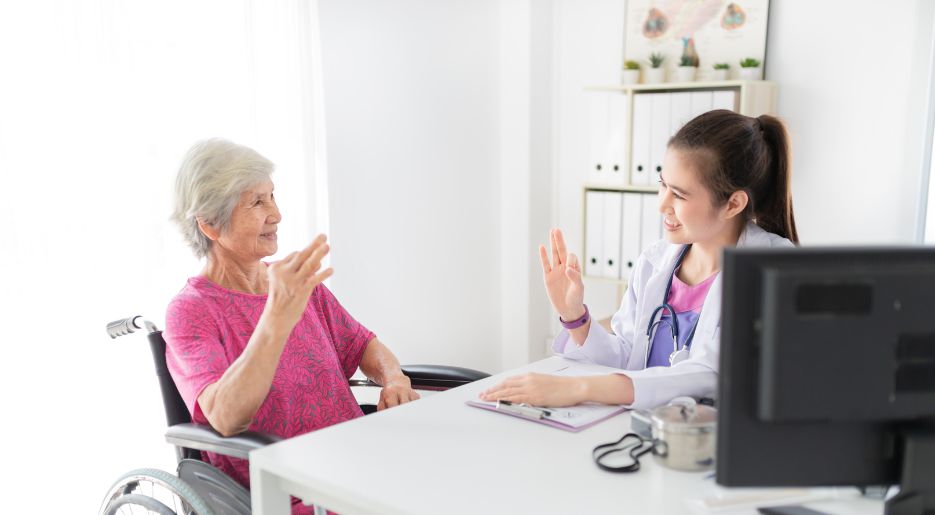18.09.2024
Healthcare Customer Experience
How new technologies are changing diagnostics and therapy
Customer experience (CX) is becoming increasingly important in the medical and healthcare industry. Patients and professionals today expect not only effective, but also user-friendly solutions – from medical products and health apps to digital health applications (DiGA). But how can companies in the medical sector meet this challenge?
What is Medical Customer Experience?
Customer experience (CX) describes the entirety of the experiences that customers have when interacting with a product, service or brand – from initial contact to long-term use. Traditionally, CX has been heavily influenced by the consumer goods and services industry, particularly in sectors such as e-commerce, retail and technology. Companies such as Apple and Amazon are considered pioneers because they have consistently placed the user experience at the center of their product development. Now CX is becoming increasingly relevant in the medical and healthcare industry. As digitalization progresses, patients and healthcare professionals have higher expectations regarding the user-friendliness and efficiency of products.
Customer experience represents the general customer experience around a company and its products – with a focus on a long-term customer relationship. Trust, data protection and integration into existing systems play an important role in health applications. CX covers all these touchpoints – before, during and after the actual use of the application.

Innovations through digitalization and AI

Digitalization and new technologies are influencing developments in the healthcare industry and at the same time enabling more precise diagnostics, personalized treatments and more efficient workflows in the healthcare sector. Innovations in the healthcare sector range from digital therapy assistants (DiGA) and telemedicine to the use of AI as a supplement to medical diagnosis. The acceptance of these technologies depends on whether their use is simple, secure and seamless – only through a positive CX can these innovations improve the healthcare system in the long term.
DiGA
- By September 2024, 35 DiGAs had been permanently included in the BfArM’s DiGA directory. These support, for example, the treatment of depression, knee problems, smoking cessation or obesity. DiGAs in particular should be characterized by a particularly user-friendly experience in order to increase patient adherence to therapy.
Telemedicine
- Dermanostic’s app, which was awarded the German Founder’s Prize 2024, offers people with skin changes uncomplicated and fast dermatological treatment.
- Noah Labs’ telemonitoring platform for cardiovascular disease connects patients and their caregivers for location-independent, data-driven care and research.
Artificial intelligence
- ViKI project research project: AI in long-term care
- TraumAInterfaces research project: AI systems for the emergency room
- GI-Insight research project: Artificial intelligence as a specialist for gastroscopies
- Research project at Cologne University Hospital: AI-supported platform for lung cancer diagnostics
- Caresyntax‘s surgical platform, which won the 2024 AI User Award, is already in use worldwide. The application uses AI to analyze huge amounts of data (e.g. for surgical planning, problem detection and monitoring) in order to improve the efficiency, safety and medical outcomes of surgical operations.
Different requirements of healthcare professionals and patients

Medical solutions must be tailored to different target groups and usage contexts. When designing the customer experience, there are differences between applications that have been developed for patients (consumer medical) and those that are intended for healthcare professionals (industrial medical). In addition, there are applications that need to cater to both target groups. The following key requirements per target group can be derived from the findings of our medical studies:
Efficiency & Safety
Medical professionals – from doctors to nurses – need medical technology that is not only efficient, but above all makes everyday clinical work easier, especially in an environment where every second counts and patient safety is a top priority.
- Intuitive operation: Devices and software should be as easy to operate as possible (“Don’t make me think!”), as the focus is on treating or diagnosing patients and not on operating machines.
- Safe design: Devices should be designed in such a way that they are comfortable and, above all, safe to use – incorrect handling can cause massive damage to health in this context.
- Precise measurement data: The devices must provide accurate and consistent results to support informed medical decisions.
- Uncomplicated cleaning and maintenance: Simple cleaning and maintenance as well as reliable service are extremely important in everyday medical practice in order to minimize downtime.
- Efficient training: Comprehensive training programs and easily accessible training materials help medical staff to handle new systems safely.
- Fast support: Availability of fast and effective technical support for questions and problems.
- Compatibility: The devices and systems should be compatible with the existing systems and software solutions.
- Fast data exchange: Data should be accessed and exchanged quickly and at the same time meet the highest data protection requirements.
- Sensible software updates: These should only be carried out if they bring about a noticeable improvement or are necessary for security reasons and require as little additional effort as possible.
- Modern technologies: Continuous further development of technologies is important in order to remain medically state of the art.
Simplicity & Trust
For many patients, illnesses or medical treatments are a source of stress – technology should not increase this stress, but minimize it.
- Simple and barrier-free operation: Devices and software should be easy and stress-free to use without prior technical knowledge – even with physical limitations.
- Stress-free use: The existing illness is often a general additional stress factor. This is when it is particularly important that the medical technology conveys the feeling that nothing can go wrong or break.
- Understandable instructions for use: The instructions for use can make a decisive contribution to improving the CX. Particular attention should be paid here to ensuring that they are written in simple language (without medical terminology), that they are structured according to the actual sequence of operating steps and that all relevant terms are listed in the table of contents and an additional index. It is also important that it is easy to read (font size!) and that the main operating steps are illustrated using figures.
- Personal information: It is important that the prescribing healthcare professional provides comprehensive and understandable information and explanations about the procedures and the purpose of the medical technology.
Medical User Research
User research is the foundation of a medical application. Through user studies, a UX design team gains insights into the needs, challenges and preferences of patients and healthcare professionals. For successful and safe operation and a good customer experience, it is essential to validate and improve UX concepts and medical prototypes at an early stage. For the certification of medical devices, the implementation of a usability engineering process in accordance with IEC 62366, including formative and summative evaluation, is therefore mandatory for manufacturers.

Technological advances and changing regulatory requirements are increasingly becoming the focus of user research. Foreseeable trends and developments that go hand in hand with a further improvement in the customer experience are already foreseeable:
- With the help of AI, large amounts of usage data can be analyzed and patterns recognized to better understand how users will interact with medical devices.
- Virtual reality (VR) and augmented reality (AR) make it possible to test prototypes of medical devices in a virtual environment before they are physically manufactured.
- Medical technology manufacturers will be able to incorporate data from the real-life use of networked mobile devices into the recording of user behavior. This “real-world evidence” can provide valuable insights that are often not visible in clinical studies.
- Advances in biotechnology and 3D printing processes will significantly improve personalization in medical technology and, as a result, individual needs will increasingly have to be identified that meet these requirements.
- Last but not least, increasing regulatory requirements, such as the MDR (Medical Device Regulation) in Europe, will force manufacturers to involve users more closely in product development.
Conclusion: Customer experience in medicine
The customer experience in medicine is complex and depends on the requirements of the respective user group. By focusing on the specific needs of both groups, companies can ensure that their medical technology is not only technologically up to date, but also creates a positive and sustainable user experience. A positive customer experience supports the success of treatment, strengthens trust in medical technologies, in the brand and in the company. And thus contributes significantly to the success of companies in the healthcare sector.
The authors
As Creative Director and UX Lead, Stefanie Angele is responsible for the holistic UX development of digital products at UID GmbH. Together with the innovation team at UID in Munich, Stefanie works closely with users and customers to develop requirements, design interaction concepts with testable prototypes and create innovative products for the world of today and tomorrow. In addition, she develops future scenarios, particularly in the medical environment, taking into account new technologies and trends in order to base corporate strategies on sound assessments.


Werner Baum is a UID specialist for user research with over 24 years of project experience. His expertise lies in the design and implementation of international research projects that incorporate a wide range of user research methods. These include usability tests, expert reviews, ethnographic studies, focus groups and user groups as well as eye tracking. In addition to designing and evaluating user interfaces for everything from consumer products to industrial machines, Werner also has extensive experience in summative and formative evaluations for medical products.
